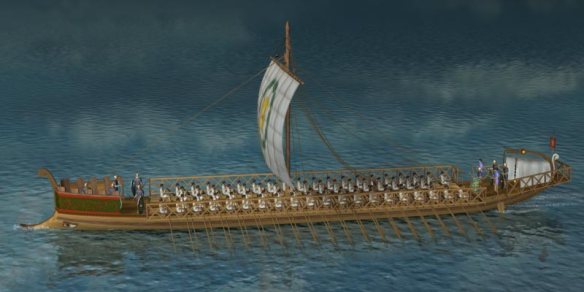Romanized Liburna during Trajan’s Dacian Wars.
Octavian had formally established the Roman imperial navy following the battle of Actium, when he sent Antony’s captured ships to Forum Iudii (present-day Frejus on the south coast of France), establishing a permanent naval base to control the northern Mediterranean. He started with two major fleet commands: Classis Praetoria Misenensis, at Misenum on the Gulf of Naples, to protect Italy itself and its grain imports in the south; and Ciassis Praetoria Ravennatis, at Ravenna at the head of the Adriatic, to deal with trouble in Dalmatia and Illyria. To protect Egypt, the source of Rome’s grain supply, Octavian created the Classis Augusta Alexandrina, at Alexandria.
Campaigns along the German Rhine (AD 5-16) necessitated creation of Classis Germanica, with heavier seagoing ships based al the river’s mouth and lighter river squadrons based at Altenburg near Cologne. The invasion and eventual conquest of Britain (AD 43-60) also required strong naval logistical support. The main Roman naval base was at Gesoraicum (present-day Boulogne) and served as the headquarters for Classis Britannica. Among the navy’s significant achievements during the conquest was its circumnavigation of Scotland, proving that Britain was an island.
After the Armenian wars, Nero (reign: AD 54-68) created the Classis Pontica to control the Black Sea. The empire’s other great water border lay along the Danube. The river splits at the Kazan Gorge, which prompted the Romans to create two fleets: Glassis Pannonica m the west and Classis Moesica in the east. Classis Moesica provided naval and logistical support to Trajan’s conquest of Dacia (AD 101-106). Under Hadrian (reign: AD 117-138) Classis Moesica controlled the mouth of the Danube and the area north, while Classis Pontica was responsible for the south and the Hellespont. Later, smaller fleets such as the Classis Nova Libyca were created to patrol the western littoral, while a larger fleet, Classis Syriaca, supported Roman forces on the border with Parthia.
Fleets were usually collocated with legion camps and provided logistical support to the army, transported troops and patrolled the rivers and coast with complements of marines. The navy remained subordinate to the army throughout the imperial period. Naval personnel did not think of themselves as sailors but as soldiers, even choosing to memorialize themselves as legionnaires on their tombstones. Naval crews were organized into centuries just like the army, and each ship had a centurion aboard with an assistant who fulfilled the role of first sergeant. The centurion was responsible for teaching infantry tactics, training his men to repel boarders or act as an assault party.
Fleets were organized into squadrons of about 10 ships. Commanding officers were drawn from the equestrian class of Roman nobles, and fleet commanders carried the rank of prefect. The sailors were free men dawn from the lower ranks of society. Few were Romans, however; most were drawn from seafaring peoples of the eastern Mediterranean or the provinces. Service was for 26 years, and citizenship was awarded on discharge.
The navy’s role changed over time, from active combat fleet 10 multipurpose military service and finally to a smaller, mobile force. Once rival navies were no longer a concern, the river fleets (Rhine, Danube and Nile) came into being to support ground operations and secure the imperial borders. Historian Publius Tacitus recorded that as early as AD 15 Germanicus’ campaign in Germany required a new type of ship to navigate the inland waterways and canals. His ships had narrow stems and bows, wide hulls and flat keels to ply the shallow rivers. They could be sailed or rowed and had covers to protect men and cargo from the weather.
Increased coastal and river patrols eventually called for a fast, light combat ship with a shallow draft. The Romans chose a modified version of Agrippa’s liburna, reduced to about 80 feet in length. Its forward-raking mast flew a single sail, while its crew of 60 manned two rows of oars. Under sail it could make close to 14 knots. Built decked or undecked, the ship could carry 30 to 50 marines, depending on the mission.
The fleets became vitally important to the defense and survival of the empire, as they patrolled its waterways and borders, safeguarding regional trade routes. In times of crisis, the navy switched roles to transport troops and supplies, but even then its light combatants could be brought into play in direct support of ground operations.
Rome ruled the seas for more than four centuries, until finally, weakened by repealed barbarian invasions from the east, it was unable to sustain the navy By 450 the Vandals had established a kingdom in North Africa and built a powerful navy. Their king, Gaiseric, sent his fleets to raid the Mediterranean coasts and shipping and eventually to attack Rome itself. By the time of Gaiseric’s death in 477, the Vandals had eliminated Rome as a naval power and become the new masters of the Mediterranean.
